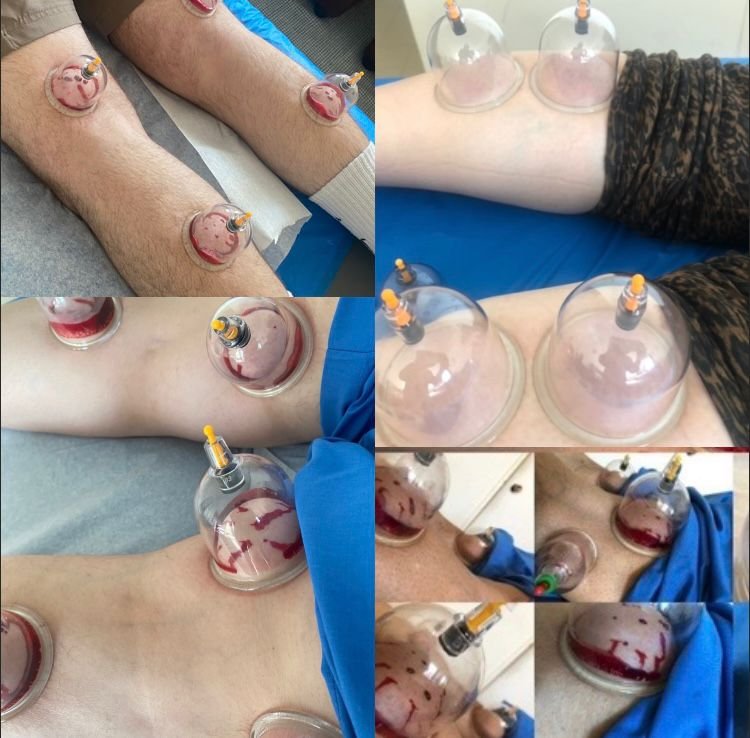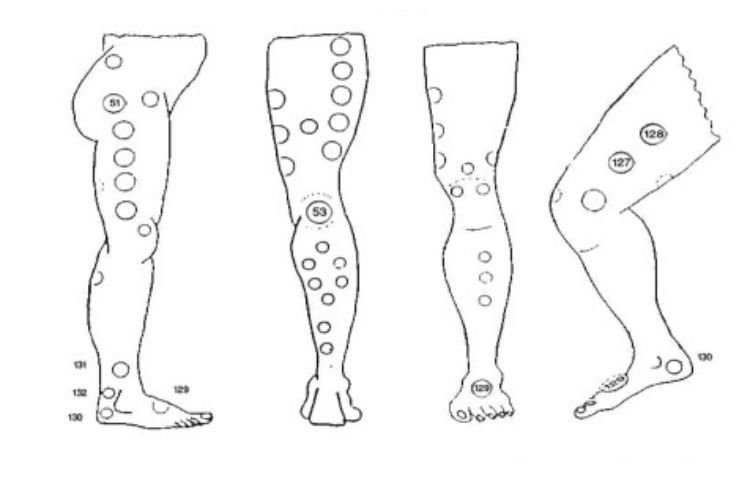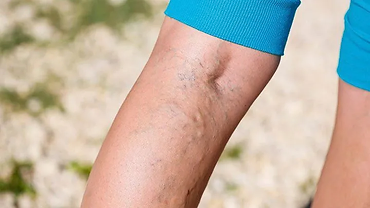No products in the cart.
Varicose Veins & Hijama Cupping Therapy
Varicose veins are a net of bluish, purplish, twisted or enlarged veins. Any twisted vein close to the skin’s surface can be varicose.

For some people, varicose veins are not considered a medical emergency, so treatment might not be necessary for them. Sometimes varicose veins can be uncomfortable and lead to some serious problems. Varicose veins develop when damaged valves in the veins allow blood to flow in the wrong direction.
Causes:
1- varicose veins may be caused by increased blood pressure in the veins.
2- Damaged valves may also cause varicose veins. The blood moves towards the heart like one-way traffic, but when the valves get damaged or don’t close properly, blood can leak back into the veins by making them enlarged.
3- Sitting or standing for a long time may also varicose veins.
4- A few health conditions that put pressure on the abdomen may also cause varicose veins, such as pregnancy, constipation, obesity or several stomach issues.
5- Sometimes, injuries in the legs may damage the valves in the veins resulting in varicose veins.
6- Blood clots in the veins or scarring of the veins can damage the valves, which could be a result of varicose veins.
7- The use of birth control pills or menopausal hormone therapy may also cause varicose veins.
Risk Factors:
The following factors can help to increase the development of Varicose veins:

- Old Age
- Obesity
- Females are more prone to varicose veins.
- Pregnancy
- Family history
- Chronic constipation
- Inactive lifestyle
- Smoking
Symptoms:
Some individuals may not have any symptoms with varicose veins. Each individual may experience symptoms differently. The following are the most common symptoms:
- Your leg may feel extremely heavy, tired or achy
- skin discolouration
- Leg cramps
- Swelling
- Itching
- Rashes
- Ulcers or non-healing sores
- Occasionally veins close to the skin burst and cause minor bleeding
Risk of Complications:
In the majority of cases, varicose veins don’t have any complications, but in a few cases, complications do occur, such as;
- Poor Blood Circulation
- Deep Vein Thrombosis (DVT)
- Venous Ulcer
- Inflammation in the veins
- Varicose Eczema
How to Prevent Varicose Veins Naturally:
A few lifestyle changes may help to prevent varicose veins, such as:
- Inactive Lifestyle: Exercise is important to lead an active lifestyle. Walking, running, and jogging are great natural ways to enhance blood flow in the legs and keep your leg muscles toned.
- Weight management: Try to maintain a healthy weight because shedding extra pounds takes unnecessary pressure off the veins of the legs and feet.
- Tight clothes: It is better to avoid tight clothes, especially around your legs and waist, because tight clothes reduce the flow of blood.
- High-Heel Shoes: Wearing high heels for an extended period can cause poor blood circulation. Low-heeled shoes improve calf muscle tone and help with the circulation of blood.
- Movement: Avoid sitting or standing in one place for longer. If your job requires you to be on your feet for a long period, then consider wearing a support hose. Or if your job makes you sit for a long period, then try standing or stretching now and then. Movement increases blood circulation and reduces buildup pressure.
- Quit Smoking: Studies have shown that smoking may develop varicose veins. The smoke an individual inhales not only affects the heart but also damages the arteries and veins. When smoking weakens the walls of the veins, it damages the one-way valve inside them, blood may begin to pool especially in the legs.
- Low-salt & high-fibre diet: Follow a low-salt diet to prevent swelling caused by water retention. A high-fibre diet helps to reduce the risk of varicose veins.
- Elevation of the legs: Elevate your legs above the level of your heart 3 to 4 times a day for about 15 minutes. Elevation of your legs may help to reduce the swelling and relieve other symptoms.
- Compression stockings: These elastic stockings restrict the veins and squeeze them to prevent blood from clotting and pooling. Compression stockings can effectively prevent varicose veins if an individual wears them every day.
A High-fibre diet & varicose veins:
The link between a high-fibre diet and varicose veins is very interesting.
Our veins have valves that keep blood flowing in one direction back to the heart. When the valves become damaged, blood can collect in the veins causing them to become enlarged. The harder the veins have to work the more varicose veins will develop.
Constipation can make the veins work harder. The strain of moving the bowels may pressure the veins, particularly in the lower legs and abdomen area. Since these veins already have to do a lot of work to push back the blood toward the heart, the additional pressure may create varicosities in the veins.

Research has shown that a high-fibre diet may reduce the risk of varicose veins, as it can eliminate painful constipation problems. Choose high-fibre foods on a daily basis.
- Whole grain bread, cereals and pasta
- High-fibre fruits like berries, pears, apples, oranges……
- High-fibre veggies like broccoli, spinach, carrots, beets, greens……
- Dried fruits like prunes, raisins…..
- Beans, lentils, peas, chia seeds, flax seeds
Worst Food Choices For Varicose Veins:
The following are some harmful poor food choices for varicose veins.
- Refined Carbohydrates, sugary and salty foods
- Fried food
- Milk and cheese can cause constipation so better to avoid them.
- White bread
- Processed food
Effective Home Remedies for Varicose Veins
Home remedies may not cure varicose veins completely, but they help reduce the symptoms. Some of the most effective home remedies for varicose veins are:
Cayenne Peppers: Individuals with varicose veins have reported cayenne peppers to be beneficial for the treatment of this condition. This pepper naturally boosts blood circulation and helps to reduce symptoms related to varicose veins.
Garlic & Ginger: These are considered one of the healthiest vegetables because of their phenomenal source of antioxidants and minerals. They remove toxins, reduce inflammation and help to improve the immune system.
Apple Cider Veniger: ACV helps speed up the cleansing process and improves circulation and blood flow. ACV can be used by adding two tablespoons of ACV to a glass of water and it can also be applied to the affected area.

Horse chestnut seeds: These seeds have anti-inflammatory and anti-swelling properties that help to reduce the symptoms of varicose veins. Horse chestnut gel is also available in the market and is very effective to apply to the affected area.
Massage: Gently massage the affected area with olive oil that keeps the blood moving through the veins. Massaging increases blood circulation and decreases pain, swelling and inflammation.
The best treatment for Varicose Veins:
There are several other treatments for varicose veins, though one of the best natural treatments is Hijama Cupping Therapy.
Hijama cupping therapy is a more effective and safe way to treat varicose veins. These veins are divided into several categories; although often located in the legs, they can occur in other parts of the body such as the pelvis and uterus. Hijama therapy has amazing results especially when we deal with health conditions related to blood. Hijama helps to abate bulging, enlarged veins. The cups cause suction on the skin around the varicose veins. The suction draws oxygen to the affected area as well as fresh blood. The new blood forces the bad blood away. As a result, dark blue veins will lighten and swelling will be reduced.
Varicose veins are caused by increased blood pressure in the veins. It happens near the surface of the skin. Cupping therapy improves the blood flow in the targetted area and helps the veins subside. During the Hijama session, the cups cause pressure on the skin which draws oxygen and fresh blood to the targetted area. Using the incisions safely can extract excess, toxic, stagnated fluids and toxins from the body.

Moving cupping, cluster cupping and wet cupping therapy are equally effective for the treatment of varicose veins. However, it may be hazardous to place cups directly on the varicose veins. Targeting systemic points at the back can improve an individual’s blood circulation. In addition to this, cups can be placed close to the veins to treat the heaviness and pain in the affected area. Varicose veins are caused by poor circulation and Hijama cupping therapy improves blood circulation.

Healthy lifestyle changes can minimize the effects of Varicose veins. Maintaining a healthy weight, avoiding sitting or standing for long periods and regular exercise can improve blood circulation and automatically decrease the symptoms of varicose veins.
Hijama cupping therapy has countless health benefits, it helps to improve an individual’s overall health.





Leave a Reply